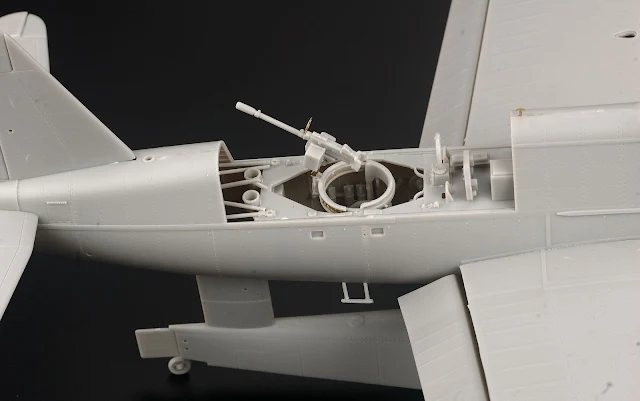The OS2U Kingfisher observation floatplane is next in the 32nd
scale catalogue from Kittyhawk. This ungainly but strangely attractive aircraft
is a great kite to have in many different scenarios on water, the air or on a
carrier deck or winch. Let’s look at the pictures of the test kit provided by
Kittyhawk.
Kittyhawk’s new OS2U
Kingfisher test kit build
The latest in a line of quite successful 32nd
scale releases, the latest kit of the recon bird famous for its work in not
only the Pacific with the US Navy but many other nations, the OS2U Kingfisher
will no doubt be popular with modellers who like navy aircraft and objects not
typical to the fighter/bomber world we see so much of.
A little about the Kingfisher first…
In the role of “eyes of the fleet” and as a recon and surveillance
aircraft the VS-310 Kingfisher was to prove the most useful and the most used. Incorporating
some revolutionary structural techniques including spot welding, the Kingfisher
was based upon the Vought company's considerable experience of observation
aircraft and was designed to replace earlier Vought biplanes in a similar role.
Operating from cruisers and battleships, these aircraft observed enemy ship
movements, spotted own ships' gunfire, and performed air-sea rescue missions.
Layout of the fuselage was similar to that employed in the
biplane scouts, as also was the use of a large single float plus underwing
stabilizing floats, users could also add a conventional tail wheel
undercarriage if needed.
Chance-Vought's XOS2U-1 was a two place mid-wing monoplane,
powered by a 450 hp Pratt & Whitney R-985-4 nine-cylinder Wasp engine. The initial
version designated the XOS2U-1 was first designed as a land plane, and the
addition of a single main float and wing-tip floats gave it a seaplane
capability. Successful catapult trials aboard the USS West Virginia (BB 48) in
August 1938 resulted in a production contract with Vought for fifty-four
OS2U-1s to be delivered over a seven-month period from May to December1940.
The OS2U-1, now designated as the "Kingfisher,"
was armed with a fixed Browning .30-caliber machine gun in the nose, and a
flexible .30-caliber gun operated by the radio operator/observer from the rear
seat position.
Operationally these birds were very useful to the US fleet
in the road back from Pearl Harbour. They sought out enemy fleets, provided
information ass the eyes of the fleet and patrolled on the lookout for threats to
the navy and located downed airmen and sunken ship’s crewmen. This plane saved
a great deal of servicemen’s lives on duty.
Operators included Australia, Chile, Cuba, Dominican Republic, Mexico,
Netherlands, Soviet Union, United Kingdom, United States, United States Navy,
United States Marine Corps, the United States Coast Guard & Uruguay.
Specifications for the
Vought OS2U Kingfisher
Crew: Two, pilot and
observer
Length: 33 ft 10 in
Wingspan: 35 ft 11 in
Height: 15 ft 1.5 in
Wing area: 262 ft²
Empty weight: 4,123
lb
Max take-off weight:
6,000 lb
Powerplant: 1× Pratt
& Whitney
R-985-AN-2 radial
engine, 450 hp
Performance
Maximum speed: 164
mph
Range: 805 mi
Service ceiling:
13,000 ft
Armament
Guns:
2 × .30 in (7.62 mm)
M1919
Browning machine guns
Bombs:
650 lb of bombs
These are the test
sprues we have already, the main fuselage and cabin internal walls.…
The tail,flying services and other small bits.
The large single float, access ladder, wheels and small side floats along with some small bombs.The large wingspan of the kingfisher with rivited surfaces evident here.
The radial engine in many parts , propeller and cowling here
…And the Kingfisher all built up as the first test shot. This model was made with the assistance of the guys at “Detail & Scale” so you know they have got their facts straight.
This is all we have right now – expect a nice build up when the kit arrives
here and any other news as soon as it comes.. Check out Kittyhawk’s website for distributors.






















